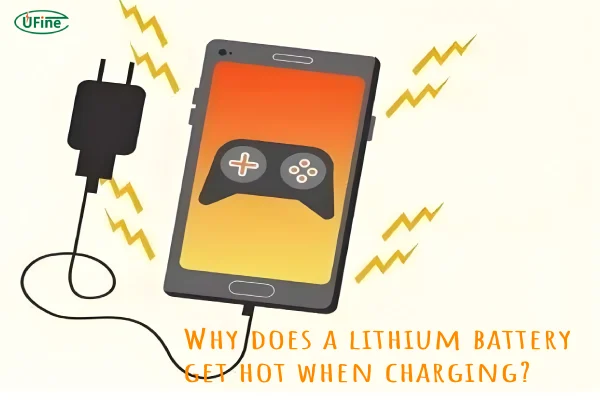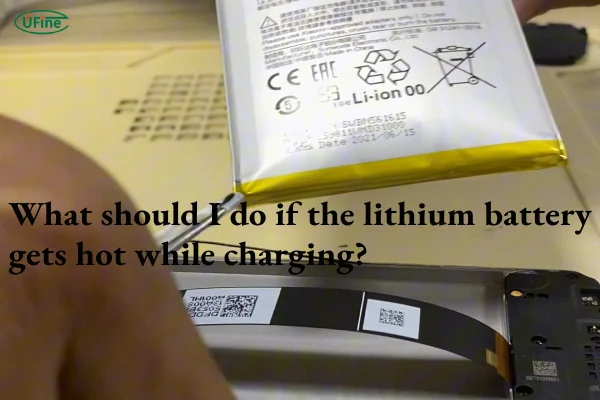With the development of science and technology, lithium batteries, as an efficient and environmentally friendly energy storage method, have been widely used in mobile communications, electric vehicles, aerospace, and other fields. Lithium batteries often get up during charging. This affects the battery’s performance and life and may also cause safety issues. Therefore, studying why lithium batteries become hot during charging and exploring corresponding solutions are of great significance to improving the efficiency and safety of lithium batteries.
Part 1. Why does a lithium battery get hot when charging?
1. Internal resistance of lithium battery generates heat
There is resistance inside the lithium battery, which generates heat when current passes through it. Lithium ions migrate from the positive electrode to the negative electrode through the electrolyte during the charging process. They are embedded in the graphite structure at the negative electrode. This process is hindered by internal resistance, which generates heat.
2. Lithium battery chemical reaction generates heat
An oxidation-reduction reaction occurs between the positive and negative electrodes when a lithium battery is charged. Heat is released during this process. The reaction speed is accelerated, especially in fast charging or high-temperature environments, and the heat generated will increase accordingly.
3. Heat conduction and heat convection
The heat generated inside the lithium battery will be transferred to the battery surface through heat conduction and heat convection, causing the battery to get hot. If heat dissipation is not timely or sufficient, the battery temperature will continue to rise.
4. External environment
External factors such as the temperature and humidity of the charging environment and the power and efficiency of the charging equipment will also affect the getting hot of lithium batteries. For example, when charging in a high-temperature environment, the battery will generate more heat.
Part 2. What effect does it have on the battery if a lithium-ion battery gets hot when charging?
1. Performance degradation
High temperatures will cause the decomposition of the electrolyte inside the battery and changes in the structure of the cathode material, thereby reducing the battery’s capacity and energy density.
2. Shortened lifespan
A continuous high-temperature environment will accelerate the battery’s aging process and shorten its service life.
3. Safety hazards
Excessive temperature may cause thermal runaway inside the battery, causing safety accidents such as battery explosion or fire.
Part 3. What should I do if the lithium battery gets hot while charging?
We can solve the problem of getting hot when charging lithium batteries from the following aspects.
1. Optimize battery design
By improving the structural design of the battery, the internal resistance of the battery is reduced, and the heat generated during the charging process is reduced. For example, optimize the formula and structural design of electrode materials, improve the conductivity and stability of electrolytes, etc.
2. Improve charging strategy
A reasonable charging strategy can reduce the battery’s getting hot during the charging process. For example, constant current and voltage charging are used to avoid excessive current causing the battery to get hot too quickly. Implement a segmented charging strategy. Adjust the charging parameters according to the battery’s actual situation to ensure the stability and safety of the charging process.
3. Strengthen heat dissipation measures
Enhancing the heat dissipation performance of the battery is an effective way to reduce charging getting hot. The cooling effect of the battery can be enhanced by adding heat sinks, improving the contact between the battery and the heat sink, and using active cooling technology (such as fans, liquid cooling, etc.).
4. Improve the thermal stability of battery materials
Developing battery materials with higher thermal stability is a fundamental solution. Improving the thermal stability of key components such as positive and negative electrode materials and electrolytes. This can reduce the battery’s getting hot amplitude under extreme conditions such as high temperature or fast charging.
5. Introducing intelligent monitoring and protection systems
Introducing intelligent monitoring and protection functions into the battery management system (BMS) can monitor key parameters such as battery temperature, voltage, and current in real-time. When an abnormality is discovered, protective measures are taken promptly, such as reducing the charging current, suspending charging, etc., to avoid the occurrence of battery thermal runaway.
6. Improve users’ security awareness and operating standards
Strengthen safety education and operational training for users. Users are reminded to charge at suitable temperatures and under environmental conditions. Avoid charging in unfavorable environments such as high temperatures or humidity to reduce the risk of the battery getting hot.
Part 3. What is the normal temperature range for charging lithium batteries?
The operating temperature range of lithium batteries is usually between -20℃ and 60℃. Within this range, the performance and discharge capacity of lithium batteries are relatively stable. However, the ideal operating temperature range is 0℃ to 40℃. Because within this range, the performance and life of the battery are optimal, and no damage will be caused to the battery.
Low temperature effect
When the temperature is below 0℃, the charging process of lithium batteries becomes difficult. The performance of the battery will decrease and the discharge capacity will also weaken. For example, at 0℃, the capacity retention rate of lithium iron phosphate batteries is about 60-70%, while at -10℃ it is 40-55%, and at -20℃ it is 20-40%.
High temperature effect
If the temperature of the battery continues to rise or is abnormally high when charging, you may need to check the battery to determine if there is a problem. High temperature may affect the life and safety of the battery.
Part 4. Will fast charging cause the battery to get hot ?
Whether it is a mobile phone or an electric car, fast charging technology will cause the battery to heat up.
Fast charging technology improves charging efficiency by increasing charging voltage and current, which will cause the internal temperature of the battery to rise. For example, mobile phone fast charging technologies such as Apple’s PD protocol and Qualcomm’s Quick Charge protocol, although designed with temperature control mechanisms, the battery temperature will still rise significantly during fast charging.
Part 5. Why does fast charging cause the battery to get hot ?
- Increase in current and voltage: Fast charging technology accelerates the charging process by increasing current or voltage, which will cause more heat to be generated inside the battery.
- Battery chemical reaction: During the charging process, the chemical reaction inside the battery will generate heat, and fast charging will accelerate this process, resulting in an increase in temperature.
- Heat dissipation problem: During fast charging, if the heat generated by the battery cannot be dissipated in time, the temperature will rise further.
Part 6. Summary
Lithium battery charging getting hot is a complex issue involving many aspects, such as the battery’s internal structure and chemical reactions, external environmental factors, and charging strategies. By optimizing battery design, improving charging strategies, strengthening heat dissipation measures, improving material thermal stability, introducing intelligent monitoring and protection systems, and improving user safety awareness and operating specifications, comprehensive measures can effectively reduce the risk of lithium batteries during the charging process. Getting hot range, improving battery efficiency and safety.
Part 7. FAQs
-
How hot is too hot for a battery when charging?
Generally, if a battery gets hotter than 120°F (49°C) during charging, it’s considered too hot and could be a safety issue. -
Can overheating damage my battery?
Excessive heat can significantly shorten a battery’s lifespan and potentially cause swelling, leakage, or even fire in extreme cases. -
Is it safe to use a battery that gets very hot when charging?
It’s not recommended to continue using a battery that overheats excessively, as it could pose a safety hazard. -
Can I put a hot battery in the refrigerator to cool it down?
No, extreme temperature changes can further damage the battery. Allow it to cool down to room temperature. -
How can I check if my charger is causing the battery to overheat?
Try charging with a different, known good charger and see if the issue persists. If not, the original charger is likely the culprit.
Related Tags:
More Articles

LiPo Battery Discharge Rate Guide & Calculation Tips
Understand LiPo battery discharge rates, C-ratings, and how to calculate max current. Essential guide for RC, drones, and electronics users.
High‑Capacity 3S LiPo Batteries: 5000 mAh vs. 10000 mAh
Compare 3S LiPo 5000mAh vs 10000mAh batteries by weight, power, and use. Find the best fit for your drone, RC car, or boat setup.
Top 5 Applications for Small 3S LiPo Batteries
Small 3S LiPo batteries power drones, RC gear, wearables, and robotics with high energy and low weight. Making them ideal for compact electronics projects.
Building and Charging Your Own 3S LiPo Pack: A Step‑by‑Step Guide
Learn how to build, balance, and charge a 3S LiPo battery pack safely at home with this complete DIY guide for hobbyists and beginners.
How to Choose the Right LiPo Battery Plug Type?
Discover the best LiPo battery plug types, how to choose them, and expert tips for safe usage, soldering, and maintenance.





